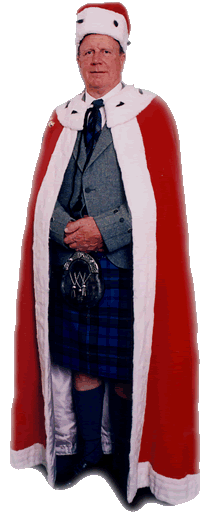 Gordon
Prestoungrange, Scottish Baron of Prestoungrange as the new millennium
dawns, is of a decidedly 21st-century mould. Unlike many of his
fourteen feudal predecessors, he has neither pledged military service to
his Sovereign beyond two years as a Flying Officer in the Royal Air Force,
nor does he enjoy any especial privileges beyond the baronial foreshore he
owns on the Firth of Forth. But then, unlike many before him, Gordon's
interest in his baronial lands and title has little to do with privilege,
but much to do with an affection for things Scottish and, specifically,
for an area of East Lothian with a colourful history where he has maternal
family roots.
Gordon
Prestoungrange, Scottish Baron of Prestoungrange as the new millennium
dawns, is of a decidedly 21st-century mould. Unlike many of his
fourteen feudal predecessors, he has neither pledged military service to
his Sovereign beyond two years as a Flying Officer in the Royal Air Force,
nor does he enjoy any especial privileges beyond the baronial foreshore he
owns on the Firth of Forth. But then, unlike many before him, Gordon's
interest in his baronial lands and title has little to do with privilege,
but much to do with an affection for things Scottish and, specifically,
for an area of East Lothian with a colourful history where he has maternal
family roots.
For Gordon his barony re-affirms a distinct sense of
identity, while it underpins his very personal vision of the further
regeneration of an economically disadvantaged community through a
combination of enthusiasm, hard work and creativity – characteristics
notable in Scotland through the ages. The community in question is that of
Prestonpans which is next door to the "Honest Toun of
Musselburgh" where his maternal grandparents lived at the turn of the
last century.
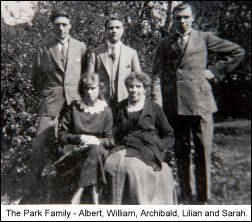 Gordon's
grandfather, James Park, worked at that time as a miner in Prestongrange
Colliery. After the First World War, as the Depression took hold, he left
Scotland, moving south as far as London to find work with his wife Sarah
and their four children, an only daughter, Lilian Audrey, and three sons,
Albert, William and Archibald (all pictured below). Lilian Audrey settled
in England, married Stanley Clifford Wills and never returned home to the
country she often spoke so fondly of from her early life on the east coast
of Scotland. In later life she emigrated to Canada (see picture below)
with her daughter Lesley Anne and son Bryan Clifford.
Gordon's
grandfather, James Park, worked at that time as a miner in Prestongrange
Colliery. After the First World War, as the Depression took hold, he left
Scotland, moving south as far as London to find work with his wife Sarah
and their four children, an only daughter, Lilian Audrey, and three sons,
Albert, William and Archibald (all pictured below). Lilian Audrey settled
in England, married Stanley Clifford Wills and never returned home to the
country she often spoke so fondly of from her early life on the east coast
of Scotland. In later life she emigrated to Canada (see picture below)
with her daughter Lesley Anne and son Bryan Clifford.
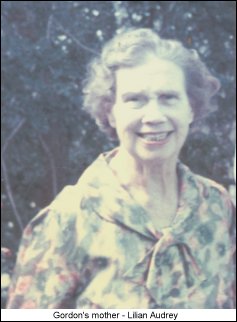 Gordon
was born and bred in London and Worthing, and never visited Scotland as a
child. From his mother he gained an impression of the Scots as a
resilient, self-confident nation with a distinct identity. He was
attracted by the fact that throughout history they had consistently taken
advantage of the opportunities that presented themselves and had been
extraordinarily successful and influential in many areas of endeavour in
countries around the world.
Gordon
was born and bred in London and Worthing, and never visited Scotland as a
child. From his mother he gained an impression of the Scots as a
resilient, self-confident nation with a distinct identity. He was
attracted by the fact that throughout history they had consistently taken
advantage of the opportunities that presented themselves and had been
extraordinarily successful and influential in many areas of endeavour in
countries around the world.
When he eventually visited Scotland for the first time,
Gordon was not disappointed. It was Christmas 1957 and he was en route
home from RAF Officer Training School at Jurby, Isle of Man. Years later,
when pondering what to do after retirement, the opportunity arose for him
to gain access to the old feudal titles and baronial lands of
Prestoungrange. He did not hesitate.
Scottish barons retained their jurisdiction and powers
much longer than barons in England. And in their time they played a major
role in restraining the absolute powers of the Sovereign and participating
over many centuries in the Scottish parliament.
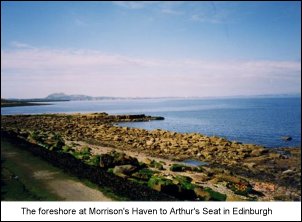 "Today,
of course," explains Gordon, "the role of a Scottish baron is
almost solely titular. The linkage between land and title has now been
separated by Act of the newly devolved Parliament. There are no powers
over the locality and the remaining estate ownership listed on the
Register of Sasines for Prestoungrange (the archaic spelling – today the
form Prestongrange is more commonly used) now mainly consists of the
foreshore at Morrison's Haven and Cuthill Rocks. Much of it is under water
at high Spring tide."
"Today,
of course," explains Gordon, "the role of a Scottish baron is
almost solely titular. The linkage between land and title has now been
separated by Act of the newly devolved Parliament. There are no powers
over the locality and the remaining estate ownership listed on the
Register of Sasines for Prestoungrange (the archaic spelling – today the
form Prestongrange is more commonly used) now mainly consists of the
foreshore at Morrison's Haven and Cuthill Rocks. Much of it is under water
at high Spring tide."
Prestoungrange yesterday and today
There is a surprising amount of historical information
on the barony and on the mixed fortunes of Prestoungrange and its owners,
and the area's history is well recounted in a series of booklets Gordon is
publishing at www.prestoungrange.org
The name Prestoungrange derives from "Prestoun", meaning
Priests' town and "Grange" denoting a farm. The earliest owners
derived their wealth from the local wool, farming and coal mining
industries.
Robert de Quincy, the first recorded owner, was
descended from Norman knights. In the twelfth century he was an important
member of the court circle of the Scottish King William I (The Lion).
Gordon relates that "de Quincy subsequently granted Prestoungrange to
Cistercian monks from Newbattle Abbey and the Order remained there for
four hundred years. The monks introduced salt panning, hence the town's
early name of Saltpreston, now Prestonpans. In the early 16th-century,
they built a nearby harbour, Newhaven, which was successively renamed
Acheson's and then Morrison's Haven. This was the first important step in
the development of the area as a significant, international manufacturing
and trading station on the Forth.
"The monks' main goal in building the early harbour
was to facilitate exports of coal, salt and hides and also to provide a
safe haven for local fishermen. Prestoungrange is reputed to have been
Scotland's first coal mining area.
"At the Reformation, the 'Commendator', or
administrator of the Cistercian estate at Prestoungrange, Mark Ker, took
possession of the properties which were subsequently granted by the King
as the Barony of Newbattle, which included the lands of Prestoungrange.
During Ker's tenure, a distinctively suggestive painted ceiling was
incorporated at the baronial home, Prestoungrange House, which may,
according to some contemporary theories, have been connected to 16th-century
practices of witchcraft. The ceiling was only discovered – to some
consternation – during renovation work in 1950 and has since been
relocated to Merchiston Tower at Napier University in Edinburgh.
"After the Ker family, who became the Earls of
Lothian, several other distinguished families held the lands and titles
including William Morison, Lord Prestoungrange, the Countess of Hyndford
and many generations of Grant Sutties. They all aided the development of a
range of secondary industries such as chemicals and soap, glass, bricks
and tiles, and pottery. The earliest sea-borne trade from the port was
with England, Holland and Sweden and this then expanded to include the
Baltic States, Germany, France, and Norway. The harbour also brought in
valuable additional revenue in the form of dues.
"Robert Ker, the second Earl of Lothian, appears to
have sold the estates because of heavy debts. In 1624 he committed
suicide, beset by further debt – a not uncommon problem among the
nobility over the centuries. Prestoungrange House was then acquired by the
Morison family, in whose hands it remained for almost 150 years until debt
– this time gambling was the cause – forced its sale to William Grant
in 1745 for the very substantial sum of £Scottish 160,000.
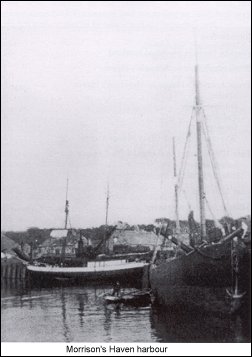 "Prior
to this William Morison had further developed the harbour, renaming it as
he did so. Trade was flourishing and, by the late 17th-century
century, as much as ten per cent of all Scotland's trade with foreign
ships passed through this port, and local fishermen had moved on from
their traditional catches to providing lobsters and, particularly, oysters
for Europe's nobility. Morrison's Haven was also renowned for widespread
smuggling and there were rumours of secret passages to the beach from
certain old houses in Prestonpans."
"Prior
to this William Morison had further developed the harbour, renaming it as
he did so. Trade was flourishing and, by the late 17th-century
century, as much as ten per cent of all Scotland's trade with foreign
ships passed through this port, and local fishermen had moved on from
their traditional catches to providing lobsters and, particularly, oysters
for Europe's nobility. Morrison's Haven was also renowned for widespread
smuggling and there were rumours of secret passages to the beach from
certain old houses in Prestonpans."
William Grant has been characterised as "an
archetypal Scottish Whig", a lawyer, supporter of the established
Church, the Union and the Hanoverian crown. He was also a Member of
Parliament from 1747 to 1754. By virtue of that office he played a
significant role in attending to matters in the aftermath of Bonnie Prince
Charlie's ill-fated attempt to reclaim the throne for the Stuarts. Grant
had the reputation locally for being rather mean, although this might be
unfair as he was known to be supportive of the local development of
industry and it was he who established the manufacture of pottery. Exports
of Prestonpans "brownware" went to Europe, North America and the
West Indies.
On Grant's death his eldest daughter, the Countess of
Hyndford, inherited Prestoungrange, there being no sons. She took the
keenest interest in the farming activities undertaken there and in her
neighbouring baronies, especially Dolphinstoun which is now held by
Gordon's youngest son Julian. On her death, it passed to her nephew Sir
James Grant-Suttie and his descendants.
Initially, this family's ownership was marked by
increasing wealth and expansion of the estate, reflecting the key
importance of coal to the Industrial Revolution. However, in the late 19th-century,
family circumstances led to the estate being managed by outside advisors
which, combined with a drop in revenue from coal, led to a decline in the
family's fortunes. While the baronial house remained in the Grant-Suttie's
ownership until 1956, for many years from 1909 it stood empty. Ironically,
the proximity of the collieries, which had for so long contributed to its
owners' prosperity, had become a liability making it unattractive to
potential lessees.
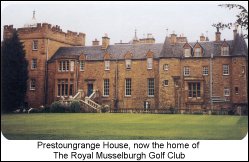 In
1924 the property was finally let to the Royal Musselburgh Golf Club (RMGC)
which was seeking to move from its existing site next to the Musselburgh
Race Course. Some thirty years later the house was put up for sale but the
RMGC was unable to raise sufficient funds to purchase it. The Coal
Industry and Social Welfare Organisation came to the rescue, buying the
house and grounds on behalf of the Musselburgh Miners' Charitable Society
and enabling the RMGC, almost half of whose members were from the mining
community, to remain there as a golfing sub-section of the society – a
mutually beneficial partnership that continues to this day.
In
1924 the property was finally let to the Royal Musselburgh Golf Club (RMGC)
which was seeking to move from its existing site next to the Musselburgh
Race Course. Some thirty years later the house was put up for sale but the
RMGC was unable to raise sufficient funds to purchase it. The Coal
Industry and Social Welfare Organisation came to the rescue, buying the
house and grounds on behalf of the Musselburgh Miners' Charitable Society
and enabling the RMGC, almost half of whose members were from the mining
community, to remain there as a golfing sub-section of the society – a
mutually beneficial partnership that continues to this day.
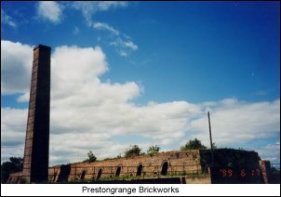 The
fortunes of the surrounding area have, however, continued their decline.
Gordon explains that "the harbour at Morrison's Haven was badly
silted up by the outbreak of the Second World War, and was filled in with
rubble and ash in the mid-1950s, trade having been diverted to road and
rail in the 1930s. The coal mine closed in the early 1960s and the
brickworks ceased operation in the mid-1970s. Other traditional local
industries such as pottery and brewing have disappeared and the local
community has for too long now suffered the consequent unemployment –
such a transformation from its vibrant past."
The
fortunes of the surrounding area have, however, continued their decline.
Gordon explains that "the harbour at Morrison's Haven was badly
silted up by the outbreak of the Second World War, and was filled in with
rubble and ash in the mid-1950s, trade having been diverted to road and
rail in the 1930s. The coal mine closed in the early 1960s and the
brickworks ceased operation in the mid-1970s. Other traditional local
industries such as pottery and brewing have disappeared and the local
community has for too long now suffered the consequent unemployment –
such a transformation from its vibrant past."
A vision of the future
Gordon Prestoungrange has a vision of what the latter
day role of a local baron might well be. Since 1998 he has sought to work
together with the community in a programme of activities that can advance
regeneration by encouraging pride in the past, promoting small industry
and, most particularly, stimulating local tourism.
The Prestoungrange Heritage Museum, established on the
site of the old colliery, is already very active in this respect. The
museum provides a graphic illustrated history of the area's thriving past
through the remaining brickworks, Cornish beam engine, mining steam and
diesel engines and their wagons, the old mining museum exhibitions and
colliery bathhouses. Greatly impressed by its work, Gordon and his son
Julian have re-established their Baron Courts of Prestoungrange and
Dolphinstoun as a non-profit organisation committed to furthering the
museum's aims and the espoused baronial vision. Gordon's own background
and ongoing interests in academic publishing and management education have
meant he was ideally placed to contribute.
A programme of activities and selection of brochures and
online publications has been launched to heighten awareness of local
history, industry and traditional skills. A Scottish artist, Janice McNab
was commissioned to produce a series of paintings. Small-scale manufacture
of pottery is being re-launched to make limited edition reproductions
together with a wholly fresh 21st Century Prestoungrange
Collection through a web-publicised competition amongst local potters.
Local people are also being invited to volunteer to join
in the painting of a selection of murals depicting their community that
further tells the history and achievements of past generations. And, most
recently, the feasibility of again brewing some of the famous old John
Fowler's Prestonpans beers from a micro-brewery is being studied.
Some Surprises Too
Gordon also has some surprises to offer locally. He
intends to convene in the area some of the other initiatives in which he
is involved outwith his barony. In Summer 2001 a marquee went up at the
Heritage Museum for a week with a spare six days available to local
societies. Its presence was required to stage the launch of Burke's
Landed Gentry: The Kingdom in Scotland, of which he is Publishing
Adviser. The BBC, Scottish TV and myriad journalists came to the museum to
report the event, the first time that title has appeared for 32 years.
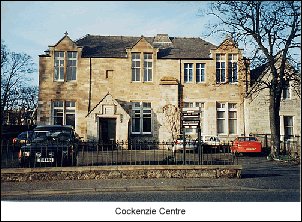 The
title also brings with it its own links to The Scottish Tartans Society's
Hall of Records, of which Gordon is The Keeper. Similar heritage
activities are expected to join the new centre being created at the 1865
Cockenzie Old School on Edinburgh Road. And in 2002/ 2003 international
meetings of The Global Association for Arts Tourism and International
Management Centres are anticipated also.
The
title also brings with it its own links to The Scottish Tartans Society's
Hall of Records, of which Gordon is The Keeper. Similar heritage
activities are expected to join the new centre being created at the 1865
Cockenzie Old School on Edinburgh Road. And in 2002/ 2003 international
meetings of The Global Association for Arts Tourism and International
Management Centres are anticipated also.
Gordon knows from overwhelming evidence around the world
that if local people can join together in such initiatives, the area can
only benefit economically. He describes his contribution as
"democratic cyber-feudalism - not absentee landlordism" and
"as deeply satisfying as it is fun". However viewed, his role
looks like a potentially winning combination of the best of traditional
"baronial values" with a new spirit of democratic
entrepreneurship, and one which he hopes local people will feel able to
accept, enjoy and exploit.

